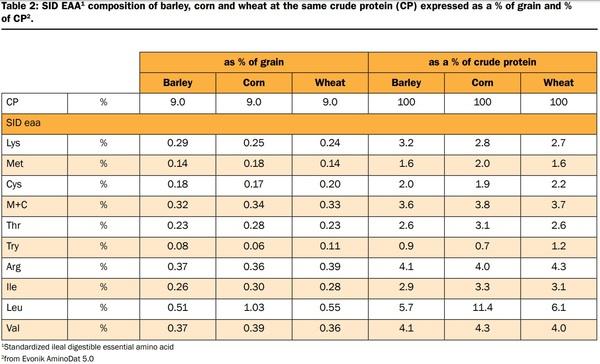Australian barley for broilers: value and opportunity
Published: November 3, 2021
By: Tim Walker / Poultry consultant, Sydney, Australia. Sponsored by AEGIC in the presentation of this paper.
Barley ranks fourth in global cereal production after corn, wheat and rice. About 65% of the world’s barley produced is fed to animals, including poultry. Australia is a significant global producer of barley, ranking in the top 5 countries with about 5% of global production and is among the top 3 barley exporters accounting for about 30% of malt and 20% of feed barley trade. Australia is a reliable supplier of two-row spring barley that is suitable for a wide range of malting, brewing and animal feed applications. Australian barley production averages about 8 million metric tonnes per year, comprised of about 5.5 million tonnes of feed and 2.5 million tonnes of malt grades. Typically, about 1.3 million tonnes of the feed barley is consumed domestically and 4.2 million tonnes exported.
The two most important nutritional attributes of grains for accurate feed formulation and value assessment for broilers are metabolizable energy (ME) and protein, or more specifically, digestible essential amino acids from the protein. Fiber and some minerals also have high importance for feed formulation.
The chemical composition and energy content of Australian grains, including barley were surveyed extensively under the ‘Premium Grains for Livestock Program’ (PGLP). NIR calibrations were developed from PGLP data, now commercialized internationally as ‘AusScan’
Almost all Australian barley is 2-row, spring type (grown in mild Australian winter), with white seed colour and hull (not ‘naked’).

Factors affecting the use of barley in broiler feeds
Starch
Starch is the main component of, and contributor to ME in all grain types. Barley has a lower starch content than corn, sorghum and wheat. The starch content of Australian feed barley typically ranges from about 55-63% dry matter (DM) (49 to 56% as-fed). Starch levels have been shown to vary from season to season and region to region. Reasons for variation include variety, soil type, fertilizer application, rainfall (yield) and general growing conditions. Low starch (possibly as low as 40%) and hence lower ME barley is usually associated with frosted and drought-affected crops. Australian research reported feed barley with high screenings did not have lower starch and ME than barley with low screenings. The amylose content of barley starch is similar to that of ‘normal’ (not waxy or high amylose) cultivars of other grains, typically 25-28% amylose and 72- 75% amylopectin. Barley starch is well digested by broilers. Ileal starch digestibility coefficients of about 0.94 have been report for barley, similar to corn.
Fiber
Non-starch polysaccharides (NSP) are the most significant fiber components of grains. Barley has a higher fiber content (NSP plus lignin), both soluble and insoluble than corn, sorghum and wheat (Table 1). Barley, wheat and rye, all ‘viscous grains’ have high levels of soluble NSP in contrast to non-viscous grains such as corn and sorghum. The predominant soluble NSP are βglucans in barley and arabinoxylans in wheat. However, barley soluble arabinoxylan content is significant. Soluble NSP are anti-nutritional in broiler feeds because of they absorb water and increase viscosity of digesta (gut contents). Higher viscosity impairs nutrient digestion and absorption and adversely affects gut health (e.g. increased microbial growth, slower passage rate). Furthermore, soluble NSP increase water consumption, resulting in wetter litter, a cause of reduced performance, increased mortality (e.g. coccidiosis) and lameness (foot pad dermatitis), and poorer product quality (e.g. breast blisters, hock burn).
β-glucans, like starch and cellulose are glucose polymers but with different glucose linkages that affect solubility and hydrolysis by digestive enzymes. β-glucans in yeast cell walls are recognized as immune-modulating. However, barley β-glucans have β-1,3 and β-1,4 linkages, different to yeast β-glucans that have β-1,3 linkages with β-1,6 side branches. The immune-modulating effects of barley β-glucans in poultry have not been adequately investigated.
The insoluble fiber content of barley is higher than the ‘naked grains’ corn, sorghum and wheat because most barley, including Australian feed barley, has a hull. Insoluble fiber is nutritionally inert and does not contribute to ME. However, insoluble structural fiber is important for gut development and health, and the higher content in barley may be beneficial for broilers.
Enzymes
β-glucans are the major soluble NSP in barley, but arabinoxylan content is significant. β-glucanase products used in many barley studies also had xylanase activity as well and may explain inconsistent responses to β-glucanase. The adverse effects of soluble NSP in barley are reduced or eliminated by exogenous β-glucanase and xylanase, and both NSP enzymes are usually included in commercial broilers feeds when barley content is above about 10%.
Metabolizable energy (ME)
Most barley ME determinations have used test diets without enzymes, fed to growing broilers.

The most common ME book value is 2,750 kcal/kg as-fed. Studies indicate an appropriate average ME value for Australian feed barley for broilers with exogenous NSP enzymes included is 2,900 kcal/kg as-fed (12% moisture basis).
Barley extract viscosity has been shown to decrease, and ME increase for typically 3 to 4 months after harvest, due to endogenous enzyme activity during storage. However, time after harvest is probably not pertinent to Asian markets because barley exported from Australia would have matured by the time it was used.
Protein/amino acids
Barley typically contains more protein than corn, 2% or more, but less than wheat. Australian feed barley protein averages about 11% DM (10% as-fed), range typically 9 to 13% DM (8 to 12% as-fed). Barley, corn and wheat protein differ in amino acid composition (amino acid as % of crude protein). The amino acid composition of a grain type is not a constant ratio to protein and in general, the essential amino acid content decreases as the protein content increases.
Protein digestibility of all cereal grains is high, but digestibility coefficients reported for barley and sorghum are lower than for corn and wheat. The lower protein digestibility of barley, but not sorghum is mainly due to soluble NSP. Evidence indicates that exogenous enzymes increase digestibility and reduce, if not eliminate protein digestibility differences between corn and viscous grains such as barley and wheat. Barley with 9% crude protein is lower in the standardized ileal digestible essential amino acids (SID EAA) methionine, M+C, threonine, isoleucine, leucine and valine than 9% corn, but similar or higher in lysine, cystine, tryptophan and arginine (Table 2). However, barley with its typically 2% higher crude protein than corn contributes more of all SID EAA except for methionine and leucine. The SID leucine: isoleucine ratio of barley protein (about 2:1) is closer to ‘ideal’ (<1.6:1) than that of corn and sorghum protein (about 3.4:1).
Oil/linoleic acid
The oil and linoleic acid contents of barley are slightly higher than wheat but lower than corn and sorghum. In high barley broiler feeds, linoleic acid would be above 1%, sufficient to meet requirement.
Vitamins and minerals
Differences in vitamin and mineral content between barley, corn, sorghum and wheat are minor and commercially irrelevant except perhaps for phosphorus (P). Total and phytate P is reported to be lower in barley and wheat than in sorghum and corn. A lower proportion of total P is in phytate form in barley and wheat (about 70%) than corn and sorghum (above 80%).
Pigments
The carotenoid pigments present in yellow corn are absent in barley, as in wheat. If barley replaces corn, pigments sources may need to be included to meet market requirements for skin color.

Mycotoxins
Australian grains, including feed barley are recognized as having low mycotoxin contamination. Generally, dry conditions at harvest, rigorous moisture testing at receival and monitoring during storage in aerated facilities contribute to this favorable mycotoxin status.
Processing
Steam cooking and extrusion are reported to increase digesta viscosity by solubilization of NSP in viscous grains and steam pelleting of barley is likely to do the same. Barley FPQF (Feed Pellet Quality Factor, Borregaard LignoTech) is the same as corn, higher than sorghum and lower than wheat (FPQF 5, 5, 4 and 8, respectively). The gelatinization temperature range of barley starch (52-60ºC) is lower than sorghum (68-78ºC), corn (62-72ºC) and wheat (58-64ºC) starch. However, due to limited moisture content and moderate temperature during conventional pelleting, starch gelatinization is not high for any grain and ranges from about 5 to 30%.
Although gelatinization may improve pellet durability index (PDI), it has not been shown to increase starch digestibility for poultry. However, physical forces of pelleting may fracture cell walls allowing greater access to digestive enzymes
Feeding whole grain to broilers has been a common practice for at least 30 years. Wheat is the grain most commonly fed whole, but barley can also be fed whole to commercial broilers.
Breeders and other poultry
Australian feed barley is suitable for all classes of poultry, and with its low mycotoxin contamination may be less risky than locally produced corn for breeders. Because of its lower energy than the other major feed grains, barley is more suited to breeder and layer than broiler feeds, but can be, and is used in broiler feeds when economic.
Practical application - value and opportunity
Barley is a proven, reliable grain for broilers. In Spain, UK, Australia and elsewhere, barley is commonly included up to 20% and occasionally above 30% in commercial broiler feeds. Australian feed barley is an opportunity worthy of consideration in the region for all poultry feeds. Barley has high soluble NSP content and β-glucanase and xylanase should be included to improve broiler performance and gut health, and reduced litter moisture. Insoluble fibre in barley may improve gut function and health.
*Dr Tim Walker (timwalkerau@gmail. com) is a consultant based in Australia. References are available for the author.

This article was also published in Asian Poultry Magazine (June/July 2020).
Related topics:
Authors:
Recommend
Comment
Share
22 de noviembre de 2021
Why should barley be considered for poultry feeding when it has superior feeding value for human beings? It tends to lower blood cholesterol and keeps away colon cancer. It has been reported to save you from coronary heart diseases. Good source of fibre for human gut. It should be considered for superior food products rather than feeding to poultry birds.
Recommend
Reply

Would you like to discuss another topic? Create a new post to engage with experts in the community.







